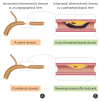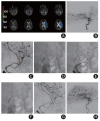Endovascular Treatment of Large Vessel Occlusion Strokes Due to Intracranial Atherosclerotic Disease
- PMID: 35135056
- PMCID: PMC8829471
- DOI: 10.5853/jos.2021.01375
Endovascular Treatment of Large Vessel Occlusion Strokes Due to Intracranial Atherosclerotic Disease
Abstract
Mechanical thrombectomy (MT) has become the gold-standard for patients with acute large vessel occlusion strokes (LVOS). MT is highly effective in the treatment of embolic occlusions; however, underlying intracranial atherosclerotic disease (ICAD) represents a therapeutic challenge, often requiring pharmacological and/or mechanical rescue treatment. Glycoprotein IIb/IIIa inhibitors have been suggested as the best initial approach, if reperfusion can be achieved after thrombectomy, with angioplasty and/or stenting being reserved for the more refractory cases. In this review, we focus on the therapeutic considerations surrounding the endovascular treatment of ICAD-related acute LVOS.
Keywords: Angioplasty; Cerebral infarction; Endovascular procedures; Intracranial arteriosclerosis; Intracranial embolism and thrombosis; Stents.
Figures







Similar articles
-
Rescue therapy after thrombectomy for large vessel occlusion due to underlying atherosclerosis: review of literature.Front Neurol. 2023 Jun 16;14:1181295. doi: 10.3389/fneur.2023.1181295. eCollection 2023. Front Neurol. 2023. PMID: 37396754 Free PMC article. Review.
-
Necessity and timing of angioplasty in acute large-vessel occlusion strokes due to intracranial atherosclerotic disease: A cohort analysis with data from the angel-ACT registry.Front Neurol. 2023 Mar 16;14:1087816. doi: 10.3389/fneur.2023.1087816. eCollection 2023. Front Neurol. 2023. PMID: 37006506 Free PMC article.
-
Angiographic And Clinical Response Of Intracranial Atherosclerotic Disease Large Vessel Occlusion Stroke Undergoing Mechanical Thrombectomy.J Stroke Cerebrovasc Dis. 2020 Oct;29(10):105148. doi: 10.1016/j.jstrokecerebrovasdis.2020.105148. Epub 2020 Jul 22. J Stroke Cerebrovasc Dis. 2020. PMID: 32912534
-
Outcomes of Endovascular Treatment for Acute Intracranial Atherosclerosis-Related Large Vessel Occlusion.Stroke. 2018 Nov;49(11):2699-2705. doi: 10.1161/STROKEAHA.118.022327. Stroke. 2018. PMID: 30355204
-
Stent-Retriever Thrombectomy and Rescue Treatment of M1 Occlusions Due to Underlying Intracranial Atherosclerotic Stenosis: Cohort Analysis and Review of the Literature.Cardiovasc Intervent Radiol. 2019 Jun;42(6):863-872. doi: 10.1007/s00270-019-02187-9. Epub 2019 Mar 11. Cardiovasc Intervent Radiol. 2019. PMID: 30859286 Review.
Cited by
-
Prediction of Intracranial Atherosclerotic Disease-Related Large-Vessel Occlusion Stroke on the Basis of Novel Cerebral Blood Volume Parameters.J Am Heart Assoc. 2024 Jan 16;13(2):e030936. doi: 10.1161/JAHA.123.030936. Epub 2024 Jan 12. J Am Heart Assoc. 2024. PMID: 38214247 Free PMC article.
-
Tigertriever in the treatment of acute ischemic stroke with underlying intracranial atherosclerotic disease.J Neurointerv Surg. 2024 Oct 14;16(11):1083-1087. doi: 10.1136/jnis-2023-020796. J Neurointerv Surg. 2024. PMID: 37777257 Free PMC article.
-
Rescue therapy after thrombectomy for large vessel occlusion due to underlying atherosclerosis: review of literature.Front Neurol. 2023 Jun 16;14:1181295. doi: 10.3389/fneur.2023.1181295. eCollection 2023. Front Neurol. 2023. PMID: 37396754 Free PMC article. Review.
-
Stent Retriever Angioplasty for Intracranial Atherosclerotic Disease-Related Medium Vessel Occlusion: A Case Report and Literature Review.J Neuroendovasc Ther. 2024;18(10):273-277. doi: 10.5797/jnet.cr.2024-0053. Epub 2024 Sep 14. J Neuroendovasc Ther. 2024. PMID: 39435175 Free PMC article.
-
Update of Anticoagulation Use in Cardioembolic Stroke With a Special Reference to Endovascular Treatment.J Stroke. 2024 Jan;26(1):13-25. doi: 10.5853/jos.2023.01578. Epub 2024 Jan 30. J Stroke. 2024. PMID: 38326704 Free PMC article. Review.
References
-
- Powers WJ, Rabinstein AA, Ackerson T, Adeoye OM, Bambakidis NC, Becker K, et al. Guidelines for the early management of patients with acute ischemic stroke: 2019 update to the 2018 guidelines for the early management of acute ischemic stroke. A guideline for healthcare professionals from the American Heart Association/American Stroke Association. Stroke. 2019;50:e344–e418. - PubMed
-
- Kang DH, Yoon W, Kim SK, Baek BH, Lee YY, Kim YW, et al. Endovascular treatment for emergent large vessel occlusion due to severe intracranial atherosclerotic stenosis. J Neurosurg. 2019;130:1949–1956. - PubMed
-
- Baek JH, Kim BM, Heo JH, Kim DJ, Nam HS, Kim YD. Outcomes of endovascular treatment for acute intracranial atherosclerosis-related large vessel occlusion. Stroke. 2018;49:2699–2705. - PubMed
Publication types
LinkOut - more resources
Full Text Sources

